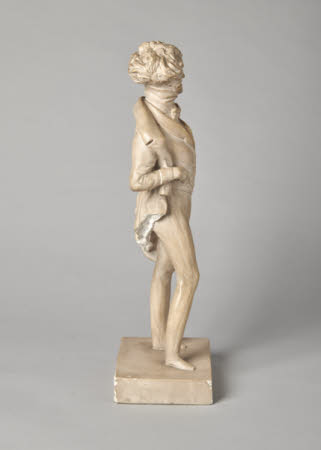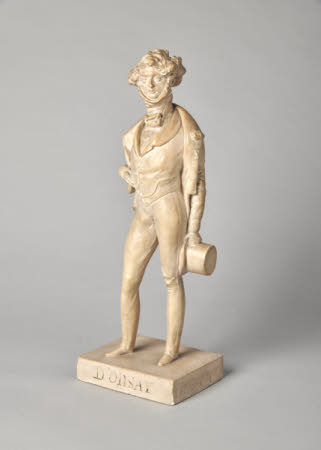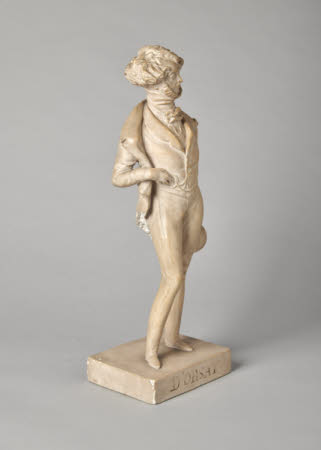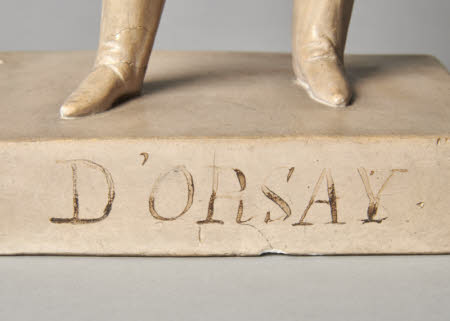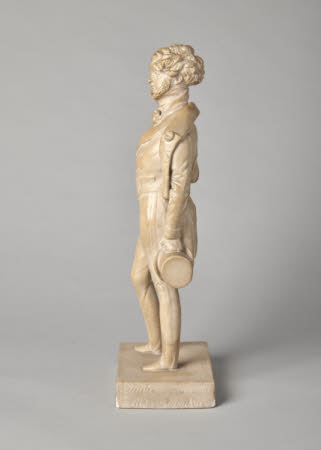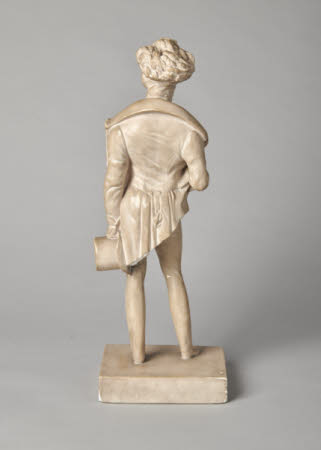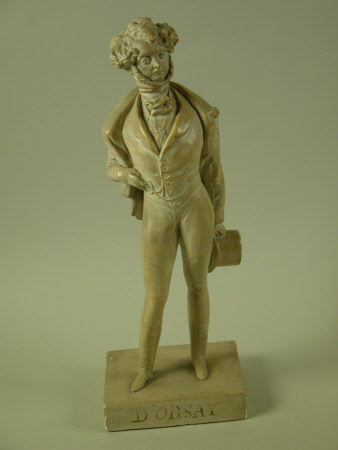Portrait statuette of Count Alfred Guillaume Gabriel d'Orsay (Paris 1801 – Paris 1852)
Jean-Pierre Dantan (Paris 1800 - Baden-Baden 1869)
Category
Art / Sculpture
Date
10 Jun 1833
Materials
Plaster
Measurements
426 x 165 x 115 mm
Place of origin
London
Order this imageCollection
Mount Stewart, County Down
NT 1221047
Summary
Sculpture, patinated plaster; Alfred Guillaume Gabriel Grimod d'Orsay, comte d'Orsay (1801-1852); Dantan jeune (Jean-Pierre Dantan, 1800-1869); 1833. A satirical portrait of the comte d’Orsay, depicting the well-known dandy and man about town in London in the 1830s as a willowy fashionably-dressed figure. One of a group of seven such caricatures , known in French as ‘portraits chargés’ or ‘charges’, made by the French sculptor and satirist Dantan jeune during his first stay in London in 1833, brought to Mount Stewart from Londonderry House.
Full description
A portrait chargé or satirical portrait of Alfred Guillaume Gabriel Grimod d'Orsay, comte d'Orsay (1801-1852), depicting the long-legged dandy fashionably dressed, his frock coat opened to show his waistcoat, with bouffant hair and carefully manicured beard. D’Orsay stands imperiously, his left hand holding his hat, whilst with his right had he reaches for the watch in his waistcoat pocket. Dantan has made d’Orsay’s neck impossibly long, with the head appearing to be squeezed out from the cravat. The portrait is on a rectangular base, with on the front D’ORSAY in ink and on one side the signature and date. The son of a Napoleonic general, d’Orsay came to London in 1821 for the coronation of King George IV and quickly struck up a close intimate friendship with the Earl of Blessington and his wife Marguerite, Countess of Blessington, with both of whom he travelled widely on the Continent. D’Orsay and lady Blessington have long been supposed to have been lovers, although the evidence for this is not conclusive. In 1827 he married Lord Blessington’s daughter Lady Harriet Gardiner, but the union was not a success. After Blessington’s death in 1829, d’Orsay and Lady Blessington returned to London and set up home in Gore House, becoming well-known figures in London society. However, d’Orsay’s extravagance caught up with him and in 1849 he became bankrupt, so that Gore House and its contents had to be sold. D’Orsay returned to Paris followed by Lady Blessington, who however died shortly after her arrival, to her friend's immeasurable grief. He himself died just a couple of years later, in 1852. Beyond his activities as a prominent society figure, the comte d’Orsay was an accomplished painter and sculptor. Like his portrait of Talleyrand (NT 1221043), in his depiction of the comte d’Orsay, Dantan spared his fellow countryman the savagery seen in some of his other London carictures, instead gently poking fun at the willowy man of fashion. The sculpture is one of a group of seven satirical statuettes by Dantan jeune at Mount Stewart (NT 1221043-1221049), all made during the sculptor’s first visits to London in 1833 and 1834. They consist of five British subjects, mostly politicians: Duke of Wellington; Earl of Sefton (twice); Samuel Rogers and Lord Brougham; and two well-known Frenchmen resident in London at the time, the diplomat Talleyrand and d’Orsay. Dantan jeune (Jean-Pierre Dantan, 1800-1869) was a successful portrait sculptor, but became famous, especially during the decade of the 1830s, for his satirical sculptures, which he called portraits chargés (‘loaded portraits’) or simply charges. For more information on Dantan and his work, see NT 1221044. Satirists had more opportunity for freedom of expression in Britain than in France, and Dantan’s British portraits chargés have been described as some of the most original and caustic of his caricatures (Sorel 1989, p. 32) and ‘as savage in treatment as any of his works’ (Seligman 1957, p. 75). During the 1830s his work was hardly less popular in London than it was in France, and he had some distinguished patrons, including the fourth Marquess of Londonderry (1805-1872), who is thought to have acquired the group of statuettes at Mount Stewart. They were found in the house in the early twentieth century and taken to Londonderry House in London, where they were displayed in the Library. The whole group was exhibited in 1931 at the Burlington Fine Arts Club, in an exhibition on English caricature. They returned to Mount Stewart after the sale and demolition of Londonderry House in 1962. The caricature of d’Orsay would have been of special interest to French audiences, and it was specifically mentioned in a report in the Court Journal for 12th October 1833: ‘Dantan, the celebrated French caricaturist, has just returned to Paris from London, having enriched his portfolio with sketches of the Earl of S---, Count d’O---y, Ro---s the poet and various other remarkable personages, whose portraits are just now attracting crowds to the windows of Susse, in the Passage des Panoramas.’ The sculpture of the comte d'Orsay at Mount Stewart is of particular importance, since it is an unrecorded model that is absent from the most important collection of Dantan jeune’s work, in the Carnavalet Museum in Paris. There is a similar statuette of d'Orsay in the Carnavalet, but it shows the subject in a slightly different pose and with even more bouffant hair, thus increasing slightly the element of satire. It is dated 13 June 1833 whereas the Mount Stewart figure was made three days earlier, on 10 June. Jeremy Warren April 2022
Provenance
Probably acquired by Frederick Stewart, 4th Marquess of Londonderry (1805-1872); by descent at Mount Stewart and Londonderry House; given to the National Trust by Lady Mairi Bury (1921-2009) in 1976
Marks and inscriptions
Front of base, in ink:: D'ORSAY Proper left side of base, incised:: Dantan je/ 10 juin 1833 London
Makers and roles
Jean-Pierre Dantan (Paris 1800 - Baden-Baden 1869), sculptor
References
Londonderry House 1939: A Catalogue and Valued Inventory of the Furniture and Works of Art at Londonderry House, Park Lane, W... Prepared for the purposes of insurance, with historical notes, by H. Clifford-Smith, 1939, p. 142. Viro 1863: [Félix Andry} Charges et bustes de Dantan jeune. Esquisse biographique, dédiée à Méry, par le docteur Prosper Viro, Paris 1863, , p. 83. Burlington Fine Arts Club: ‘Catalogue of a Collection of English Caricature, Winter 1931/1932’, London 1931, no. 202. Montgomery Hyde 1937 H. Montgomery Hyde, Londonderry House and its Pictures, London 1937, p. 18, Pls. IV and XV. Hale 1940 : Richard Walden Hale, Dantan, jeune 1800-1869, and his satirical and other sculpture, especially his “portraits chargés’, Needham, Mass. 1940., p. 12. Seligman 1957: Janet Seligman. Figures of fun: the caricature-statuettes of Jean-Pierre Dantan, London 1957., pp. 76-77, 141. Sorel 1986: Philippe Sorel, ‘Les Dantan du Musée Carnavalet. Portraits-charges sculptés de l’époque romantique’, Gazette des Beaux-Arts,, 107 (1986), pp. 1-38 and 87-102, p. 90, no. 214 (variant). Sorel 1989: Philippe Sorel, ‘Dantan jeune. Caricatures et portraits de la société romantique’, exh. cat., Maison de Balzac, Paris 1989., p. 172, no. 198 (variant).

